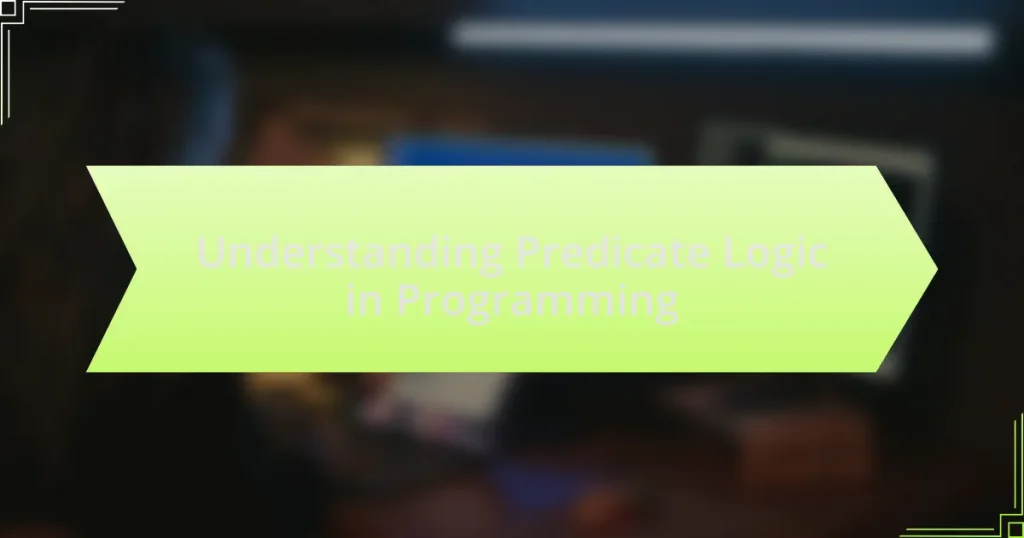Logic programming is a programming paradigm grounded in formal logic, with Prolog being a prominent language that exemplifies this approach. The article provides a comprehensive overview of logic programming and Prolog, detailing its fundamental principles, key features, and differences from other programming paradigms. It explores how Prolog handles facts and rules, the significance of backtracking, and common applications in artificial intelligence and natural language processing. Additionally, the article offers guidance for beginners on setting up Prolog, writing code, and overcoming challenges, along with best practices and debugging techniques to enhance programming efficiency.

What is Logic Programming and Prolog?
Logic programming is a programming paradigm that is based on formal logic, where program statements express facts and rules about problems within a system of formal logic. Prolog, which stands for “Programming in Logic,” is a specific logic programming language that utilizes a set of facts and rules to derive conclusions through a process called resolution. Prolog was developed in the early 1970s and is particularly well-suited for tasks that involve symbolic reasoning and non-numeric computation, such as natural language processing and artificial intelligence. Its foundation in first-order predicate logic allows for powerful querying capabilities, enabling users to define relationships and perform logical inference efficiently.
How does Logic Programming differ from other programming paradigms?
Logic programming differs from other programming paradigms primarily in its approach to problem-solving, which is based on formal logic rather than procedural or object-oriented methods. In logic programming, such as Prolog, programs consist of a set of facts and rules that define relationships and allow for inference, enabling the system to derive conclusions from the provided information. This contrasts with imperative programming, where the focus is on explicitly defining a sequence of commands to achieve a desired outcome, and with object-oriented programming, which emphasizes encapsulation and the manipulation of objects. The unique characteristic of logic programming is its reliance on logical statements and the use of a query mechanism to derive answers, making it particularly suited for applications in artificial intelligence and knowledge representation.
What are the fundamental principles of Logic Programming?
The fundamental principles of Logic Programming include the use of formal logic as a programming paradigm, where programs are expressed in terms of relations and rules rather than procedures. Logic Programming is based on the concepts of facts, rules, and queries, allowing for declarative problem-solving. In this paradigm, a program consists of a set of logical statements that describe the relationships between different entities, enabling the inference of new information through a process called resolution. This approach is exemplified in languages like Prolog, which utilizes a backward chaining algorithm to derive conclusions from given facts and rules.
Why is Prolog considered a logic programming language?
Prolog is considered a logic programming language because it is based on formal logic, specifically first-order predicate logic, allowing programmers to express facts and rules about problems in a declarative manner. In Prolog, computation is performed through logical inference, where the system derives conclusions from the given facts and rules, rather than through explicit procedural instructions. This characteristic aligns with the principles of logic programming, where the focus is on what the program should accomplish rather than how to accomplish it, enabling a more natural representation of knowledge and problem-solving.
What are the key features of Prolog?
Prolog’s key features include its foundation in logic programming, support for symbolic reasoning, and a declarative syntax that allows users to express facts and rules. The language utilizes a backtracking algorithm for query resolution, enabling efficient search through possible solutions. Additionally, Prolog supports unification, which is a process that matches terms and variables, facilitating pattern matching and inference. These features make Prolog particularly suited for applications in artificial intelligence, natural language processing, and knowledge representation.
How does Prolog handle facts and rules?
Prolog handles facts and rules through a declarative programming paradigm where facts represent basic assertions about the world, and rules define relationships and logical inferences based on those facts. In Prolog, facts are stated in the form of predicates, such as “parent(john, mary),” indicating that John is a parent of Mary. Rules are expressed using implications, typically in the format “if condition then conclusion,” allowing Prolog to derive new information from existing facts. For example, a rule like “grandparent(X, Y) :- parent(X, Z), parent(Z, Y)” states that X is a grandparent of Y if X is a parent of Z and Z is a parent of Y. This structure enables Prolog to perform logical reasoning and query processing effectively, allowing users to ask questions and retrieve answers based on the defined facts and rules.
What is the significance of backtracking in Prolog?
Backtracking in Prolog is significant because it enables the language to explore multiple potential solutions to a problem efficiently. This mechanism allows Prolog to systematically search through possible combinations of facts and rules, reverting to previous states when a solution path fails. For instance, when a query does not yield a result, Prolog automatically backtracks to the last decision point, trying alternative options until it finds a valid solution or exhausts all possibilities. This capability is essential for solving complex problems, such as puzzles or logical reasoning tasks, where multiple paths may lead to different outcomes.

How do you get started with Prolog?
To get started with Prolog, first install a Prolog interpreter such as SWI-Prolog, which is widely used and freely available. After installation, familiarize yourself with the syntax and basic concepts of Prolog, including facts, rules, and queries. Engaging with online tutorials and documentation, such as the official SWI-Prolog documentation, can provide structured learning. Additionally, practicing by solving simple problems and gradually increasing complexity will enhance your understanding and proficiency in Prolog programming.
What tools do you need to install Prolog?
To install Prolog, you need a compatible Prolog interpreter or compiler, such as SWI-Prolog or GNU Prolog. SWI-Prolog is widely used and available for multiple operating systems, including Windows, macOS, and Linux. GNU Prolog is another option that is known for its efficiency and is also cross-platform. Both tools provide the necessary environment to run Prolog programs effectively.
Which Prolog environments are recommended for beginners?
SWI-Prolog and GNU Prolog are recommended Prolog environments for beginners. SWI-Prolog offers a user-friendly interface, extensive documentation, and a large community, making it accessible for newcomers. GNU Prolog is lightweight and provides a straightforward installation process, which is beneficial for those just starting with Prolog. Both environments support standard Prolog features and have resources available for learning, ensuring that beginners can effectively grasp the fundamentals of logic programming.
How do you set up your first Prolog program?
To set up your first Prolog program, you need to install a Prolog interpreter, such as SWI-Prolog, and create a text file with a .pl extension containing your Prolog code. After installation, you can write simple facts and rules in the text file, such as “parent(john, mary).” to declare that John is a parent of Mary. You then load this file into the Prolog interpreter using the command “consult(‘filename.pl’).” This process allows you to execute queries against the defined facts and rules, demonstrating the functionality of your Prolog program.
What are the basic syntax and structure of Prolog?
Prolog’s basic syntax consists of facts, rules, and queries. Facts are simple assertions about objects or relationships, written as predicates followed by a period, such as “parent(john, mary).” Rules define relationships using the “:-” operator, indicating that if certain conditions are met, then a conclusion can be drawn, for example, “grandparent(X, Y) :- parent(X, Z), parent(Z, Y).” Queries are questions posed to the Prolog system, typically initiated with a variable, like “?- parent(john, X).” The structure of Prolog programs is generally a collection of these facts and rules, which together form a knowledge base that the Prolog interpreter can use to infer new information.
How do you define facts in Prolog?
Facts in Prolog are defined as basic assertions about the world that are unconditionally true. They are represented in the form of predicates followed by their arguments, such as “parent(john, mary).” This statement asserts that John is a parent of Mary. Facts serve as the foundational building blocks in Prolog, enabling the system to derive further knowledge and relationships through rules and queries.
What is the format for writing rules in Prolog?
The format for writing rules in Prolog is defined as a head and a body, where the head represents a predicate and the body consists of conditions that must be satisfied for the head to be true. Specifically, a rule is written in the form: Head :- Body. For example, the rule “parent(X, Y) :- father(X, Y).” states that X is a parent of Y if X is a father of Y. This structure allows Prolog to infer relationships and derive conclusions based on the defined rules.

What are common applications of Prolog?
Common applications of Prolog include artificial intelligence, natural language processing, and expert systems. In artificial intelligence, Prolog is utilized for tasks such as knowledge representation and reasoning due to its logical foundation. In natural language processing, Prolog aids in parsing and understanding human languages through its pattern-matching capabilities. Additionally, expert systems leverage Prolog for decision-making processes, allowing for the representation of complex rules and relationships in various domains, such as medical diagnosis and financial forecasting. These applications demonstrate Prolog’s effectiveness in handling symbolic reasoning and complex problem-solving tasks.
How is Prolog used in artificial intelligence?
Prolog is used in artificial intelligence primarily for knowledge representation and reasoning. It enables the creation of complex systems that can infer conclusions from given facts and rules, making it suitable for applications such as natural language processing, expert systems, and automated theorem proving. Prolog’s logical syntax allows for the expression of relationships and rules in a way that machines can process, facilitating tasks like problem-solving and decision-making. Its effectiveness is evidenced by its use in various AI projects, including the development of chatbots and intelligent agents that require understanding and manipulation of knowledge.
What role does Prolog play in natural language processing?
Prolog plays a significant role in natural language processing (NLP) by providing a framework for symbolic reasoning and knowledge representation. Its logic-based approach allows for the parsing and understanding of natural language through rules and facts, enabling systems to infer meaning and relationships within text. Prolog’s ability to handle complex queries and backtracking makes it particularly effective for tasks such as syntactic parsing, semantic analysis, and dialogue systems, where understanding context and structure is crucial. This capability is supported by its use in various NLP applications, including chatbots and language understanding systems, demonstrating its practical utility in the field.
How can Prolog be applied in expert systems?
Prolog can be applied in expert systems by enabling the representation of knowledge through facts and rules, facilitating logical inference. Expert systems utilize Prolog’s capabilities to encode domain-specific knowledge, allowing the system to derive conclusions based on the provided information. For instance, Prolog’s backtracking mechanism efficiently explores possible solutions, making it suitable for complex problem-solving tasks in fields like medical diagnosis and troubleshooting. The effectiveness of Prolog in expert systems is evidenced by its use in various applications, such as MYCIN, an early expert system for diagnosing bacterial infections, which successfully demonstrated Prolog’s ability to handle intricate rule-based reasoning.
What are some challenges beginners face when learning Prolog?
Beginners face several challenges when learning Prolog, primarily due to its unique paradigm and syntax. One significant challenge is understanding the declarative nature of Prolog, which contrasts with imperative programming languages; this requires learners to think in terms of relationships and rules rather than step-by-step instructions. Additionally, mastering backtracking and recursion can be difficult, as these concepts are central to Prolog’s execution model and may be unfamiliar to those coming from other programming backgrounds. Furthermore, beginners often struggle with the syntax, which can be less intuitive compared to more widely-used languages, leading to confusion and frustration. These challenges are well-documented in educational resources and studies on programming language acquisition, highlighting the need for targeted learning strategies to overcome them.
How can you overcome common pitfalls in Prolog programming?
To overcome common pitfalls in Prolog programming, developers should focus on understanding the declarative nature of the language and utilize proper debugging techniques. Recognizing that Prolog operates on logical relationships rather than procedural steps helps prevent misunderstandings in code structure. Additionally, employing tools like trace and debug predicates allows programmers to analyze the execution flow and identify logical errors effectively. Research indicates that many beginners struggle with recursion and backtracking; thus, practicing these concepts through examples can enhance proficiency and reduce mistakes.
What resources are available for further learning in Prolog?
Books such as “Programming in Prolog” by Clocksin and Mellish and “Prolog Programming for Artificial Intelligence” by Ivan Bratko are essential resources for further learning in Prolog. These texts provide foundational knowledge and practical applications of Prolog in various domains, including artificial intelligence. Additionally, online platforms like Coursera and edX offer courses specifically focused on Prolog, allowing learners to engage with interactive content and exercises. The official SWI-Prolog website also provides extensive documentation and tutorials, making it a valuable resource for both beginners and advanced users.
What are best practices for writing Prolog code?
Best practices for writing Prolog code include using clear and descriptive predicate names, structuring code for readability, and leveraging built-in predicates effectively. Clear predicate names enhance code comprehension, while structured code, such as using indentation and comments, aids in maintaining and debugging. Utilizing built-in predicates, like member/2 and append/3, optimizes performance and reduces the need for custom implementations. These practices are supported by the Prolog community’s emphasis on code clarity and efficiency, which are essential for effective logic programming.
How can you optimize Prolog queries for better performance?
To optimize Prolog queries for better performance, you can utilize indexing, which significantly speeds up the retrieval of facts. Indexing allows Prolog to quickly locate relevant clauses by creating a data structure that maps terms to their corresponding predicates. Additionally, you can minimize backtracking by structuring your predicates to reduce unnecessary search paths, such as using cuts to limit the scope of search. Furthermore, organizing your facts and rules in a way that promotes efficient access patterns, such as grouping related predicates together, can enhance performance. These strategies are supported by empirical evidence showing that well-structured Prolog programs can execute queries several times faster than poorly structured ones.
What debugging techniques are effective in Prolog?
Effective debugging techniques in Prolog include using trace, debug, and listing predicates. The trace command allows users to step through the execution of a program, providing insights into the flow of control and variable bindings. The debug command offers a more interactive debugging session, enabling users to examine the state of the program at specific points. Additionally, the listing predicate displays the definitions of predicates, helping to verify their correctness. These techniques are essential for identifying logical errors and improving program reliability in Prolog.



